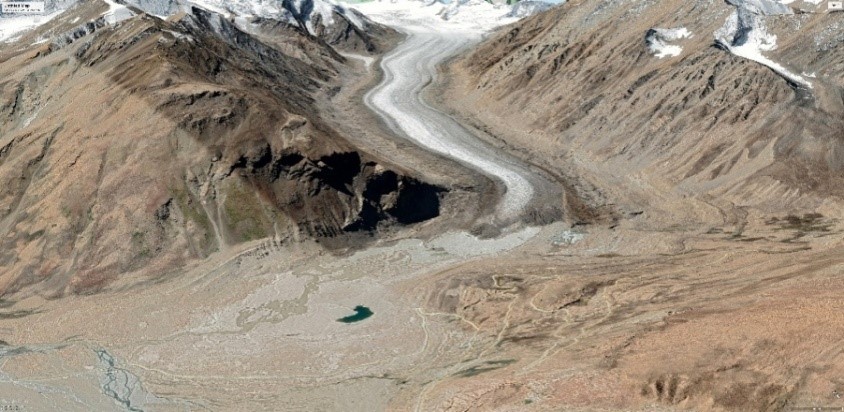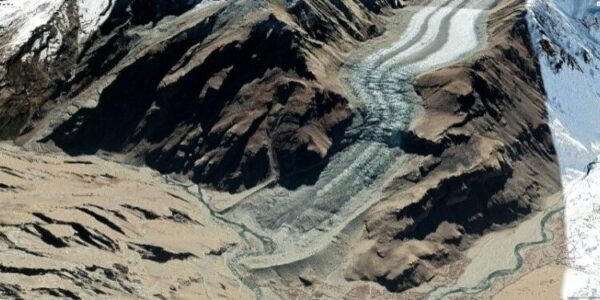Receding Glaciers of Ladakh – A Clarion Call
Ladakh is often called an “Arid desert” as it falls in “rain shadow zone”. The main sources of irrigation are perennial rivers fed by glaciers and streams fed by seasonal snow and aquifers with catchment confined within spurs. While gravity canals taking off from rivers irrigate moderate to low laying land along river valleys, small water channels known as “khul” in revenue parlance taking off from streams irrigate land on higher contours in valley settlements.
Till recent past, Ladakh used to be pollution-free and heavy to moderate snowfall through winter ensured availability of water for irrigation as also recharge aquifers and replenish glaciers. Life thus sustained for centuries till global warming due to rapid industrialization and pollution due to emissions from fossil fuel had a profound effect on the fragile ecosystem of Ladakh leading to receding of snowline, depleting glacial cover and drying up of springs. Although the effects are all-round, some hard evidence of glaciers receding/ shrinking at an alarming rate would make planners sit up and take notice:
World-famous Nun Glacier at Parkachik in Suru valley Kargil which was abutting left bank of river Suru three decades ago have receded by around 500 meters and also shrunk in expanse, thus exposing the debris underneath as is evident from Plate -1.
* Click to Follow Voice of Ladakh on WhatsApp *

Drung-Drung glacier at water shed of Penzila pass in vicinity of Kargil-Zanaskar road have receded by at least a km and shrunk in expanse forming a glacial lake and exposing glacial debris as is evident from Plate-2.

Similarly, glaciers feeding tributaries to river Suru have also receded considerably. Situation of glacial melting in Leh is more alarming. “Stok khangri” glacier famous among mountaineers have almost disappeared.
Khardongla pass at around 18300ft altitude on Leh-Nubra road, where a bridge was laid over a glacier crevasse on Northern side to cross over till a decade ago, is bereft of any glacier and a dusty road at 18000ft is a sign of “coming events cast their shadow before”.
At Changla on Leh-Durbuk road, at almost similar altitude to Khardongla, the road passes through glacial debris of what was once under glacier
A recent study by Kashmir University’s Geo Informatics Dept. revealed that glaciers in J&K and Ladakh are melting at an alarming rate. According to the study, Zanaskar range is losing thickness at the rate of 117 cm per year followed by Ladakh range at the rate of 46 cm per year.
Evidently, over the years the snow line has receded considerably, which is a cause of alarm and hence “A Clarion call”.
Meteorological data reveal that rate and spread of snowfall have decreased over the years and average temperature have increased accelerating rate of melting, thus causing gradual depletion and shrinking of glaciers. It also had a profound effect on recharging of underground aquifers, which is noticeable from gradual decrease in flow of streams and springs.
A recent report on “Assessment of climate change over Indian region” by Union Ministry of Earth Sciences have concluded that Hindukush Himalayas has warmed at a rate of 0.2 degree per decade during last 70 years, leading to decline in snow cover and glaciers.
Signs of springs drying up are evident from recent social media posts by concerned citizens. A resident of Gompa village in upper Leh posted a picture of dried up “Spang” (a lush green patch fed by spring), where animals graze and wanted to know the cause.
Indian Express recently published an article on village Kulum near Upshi in Leh district, where villagers, unable to carry out traditional agrarian practices due to drying up of spring, were forced to abandon village due to water scarcity in 2012. They returned only when “Ice Stupa’s” were built to conserve winter flow in shape of ice, providing much needed water at time of sowing. The Article goes on to warn that with increasing average temperature and shrinking glaciers, several villages in Ladakh have imminent danger of turning into ghost towns.
In Leh District scarcity of water for irrigation in near future are likely to be felt mainly in Leh town and villages on higher contours (Pho) located along southern foothills of Khardongla-Changla axis from village Shara to village Umla and beyond.
In Kargil district, villages lying between river Indus and Wakha nallah on higher contours dependent on seasonal snow including Soth area, villages in upper Phokhar-Pho nallah and upper reaches of Kargil Town, to cite a few, face frequent draught when snowfall is less as glaciers feeding these streams have almost vanished. There may be many more villages facing similar situation of water scarcity in both Districts, which may have escaped my notice.
Mitigating measures:
Though there are many brilliant minds in Ladakh, who can suggest better solutions/ alternatives to mitigate the adverse effect of global warming and climate change on the fragile ecology of Ladakh. Yet I thought it my bounden duty to put forth some suggestions from an Engineers point of view for further discussion amongst all stakeholders:
- Engage consulting Glaciologists and Hydrologists of International repute for in-depth study of causes, measures to prevent further shrinkage and possible replenishment of glaciers. In Leh Town, the study of the effect of a large number of tube wells at shallow depths drawing water from the subterranean flow of Leh nallah and its effect on reduction in the surface flow should be carried out through reputed hydrologists. As an interim measure, only deep tube wells drawing water below the water table of Indus River should be allowed.
- Survey, investigation and feasibility study of potential irrigation projects from perennial sources i.e. rivers for vulnerable villages through dedicated Engineering Divisions in both Districts. In order to bring additional area within the command of the proposed irrigation project, a combination of gravity canal, reservoir and lift by solar/ Hydropower or vice versa can be thought of to bring the additional area under command at a lower level to compensate for the loss of cultivable land in higher reaches.
- One of the many causes of depletion of the glacier at Khardongla and Changla is due to emission from a large volume of traffic plying round the year. The viability of providing a highway tunnel across these passes should be explored to reduce the effects of carbon emission.
- For villages high up in valleys- both in Leh and Kargil Districts, which remain outside command of proposed irrigation projects taking off water from rivers, the only hope apart from natural intervention would be the concept of artificial glaciers or “Ice Stupas” (Plate-3) conceptualized by SECMOL led by Magsaysay awardee Sh. Sonam Wangchuk, which have given hope to villages facing acute scarcity of water in both Leh and Kargil districts. However, for this to succeed, UT Administration and LAHDC’s should approve it as “Water conservation project” in water deficit villages to be fully financed by Govt. under MGNREGS or any other scheme.
- In water deficit areas of Kargil Snow check dams built in a narrow portion of valley in past proved effective to retain snow avalanches, thus increasing the period of melting. These are gravity structures of drystone masonry in crate wire mesh, which are flexible and easy to maintain. Such avalanche retaining structures can be thought of in valleys where moderate snowfall triggers avalanches.
- In Kargil and Zanskar, there is huge potential of new irrigation schemes on rivers Zanskar, Suru, Drass and its tributaries. All such potential sites should be surveyed for feasibility and a shelf of DPR’s is prepared for taking up as per priority. To bring land on higher contours under irrigation, a combination of gravity canal & lift irrigation by solar/ hydropower pumps can be explored.
History is replete with instances where civilizations have thrived on dependable irrigation system and also of civilizations, which perished only because of failed irrigation systems – be it natural or manmade. It is an irony that although Ladakh and particularly Leh District have vast tracks of barren land on either side of river Indus, yet only a fraction of this natural resource has been utilized for irrigation. One of the reasons for this could be economic prosperity, which tourism brought to the region in last three decades. However, the recent pandemic has proved how fragile this economic prosperity is. Also, with a large number of educated youths competing for a limited number of jobs, the prospect of employment to all appears bleak. Here, I’m reminded of an ancient Ladakhi proverb, “Mee boubs na saa hRthan”; roughly meaning – “draw sustenance from land, when other means is beyond endurance.” It is therefore incumbent on all stake holders to reflect and strive to harness sustainable livelihood from natural resources of “Water, land & sun”.
The upside of rise in temperature has increased the prospects of diversification in cultivation by way of organic cash crops like variety of vegetables & fruits. Coupled with mechanised farming and introduction of Atmospheric Controlled Storage, farming as a profession can be economically viable and is likely to attract educated youth. It is high time that UT administration, LAHDC’s Leh and Kargil, planners and civil society come together to make tangible efforts to address the long-term effect of climate change on irrigation prospects and think of out of box solutions to not only protect the existing irrigated land, but also create additional potential of irrigable land. The additional resources made available to UT are best utilized to harness natural resources of Ladakh for sustainable development.

0 Comments